Dental Implants – Alexandria, VA
Setting the Foundation
for a New Smile
Many dentists recommend dental implants to replace any number of missing teeth, but they often lack the training and experience to place them. Since dental implants are meant to last for decades, the procedure should only be performed by a true expert, which is where our team at Northern Virginia Oral, Maxillofacial & Implant Surgery comes in. We’ll handle the surgery, so you can fully enjoy the benefits of what many call the gold standard for replacing teeth - dental implants from our Alexandria, VA oral surgeons.
Why Choose Northern Virginia Oral, Maxillofacial & Implant Surgery for Dental Implants?
-
Board-Certified
Oral Surgeons -
All-on-4 Implant
Dentures Available - State-of-the-Art Guided Implant Surgery
What Are
Dental Implants?
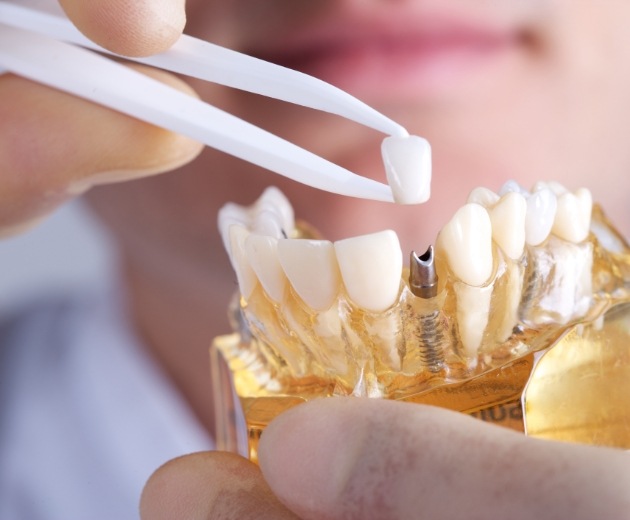
Dental implants are artificial tooth roots that an oral surgeon embeds into your jawbone. Made of titanium, a biocompatible metal, implants fuse with your jawbone as you heal from the surgery. This process, called osseointegration, makes your implant a permanent and extremely durable replacement for your natural tooth root.
While a dental implant replaces your tooth structure below your gum line, it also serves as an anchor onto which the team can affix a crown, bridge, or denture using All-on-4® implants. The team at Northern Virginia Oral, Maxillofacial & Implant Surgery designs your restoration so that it fits perfectly into your smile, supports a healthy bite, and helps you more easily chew your food.
They even give you the option of using porcelain for your restoration, which has a similar color and translucent character to your natural tooth enamel, and therefore blends in aesthetically with the rest of your smile.
Partners with
Your Dentist

Placing and restoring implants often calls for a team-based approach, which is why your dentist may refer you to us when you decide to get dental implants. Our talented specialists can perform the surgery and some of the necessary preliminary work while your dentist takes the necessary impressions to design the final restoration. Furthermore, your dentist will provide us with important information about your oral health so that we can make any necessary accommodations.
4 Step Dental Implant Process
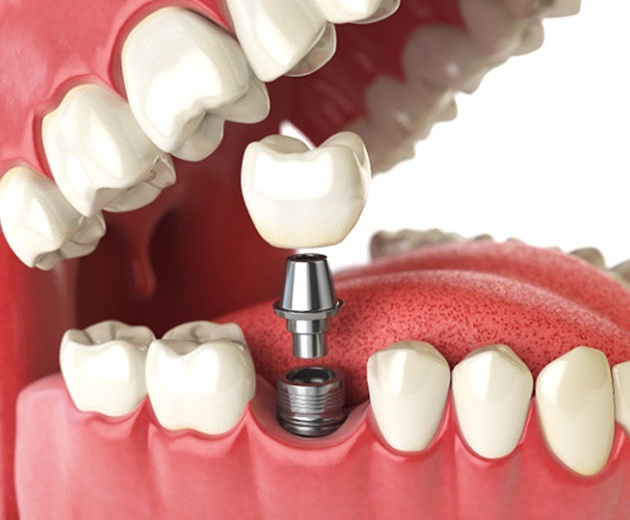
Unlike traditional replacement options (dentures and bridges), dental implants require a unique process that spans over months. This may seem like a long time, however this amazing replacement comes with various benefits you can’t get anywhere else. No two treatments are the same, yet every patient can expect the following 4 main steps: consultation, surgery, osseointegration, and delivery of final restoration. For any specific questions, please don’t hesitate to contact our office. Until then, read on to learn more about how dental implants work in Alexandria.
Initial Dental Implant Consultation

Before getting dental implants, you’ll start with an initial consultation. One of our experts will review your medical history and carefully examine your mouth. In many cases, we’ll recommend preliminary treatments to prepare your mouth for surgery. These often include tooth extractions, bone grafting, and gum disease therapy. Thankfully, we provide most of these services at our office – they are integral for the overall success of your dental implants.
Dental Implant Surgery
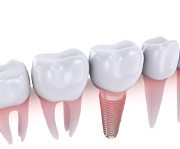
Next, you’ll visit our office for implant surgery. We will start by ensuring that your mouth is completely numb for total comfort. If you’re looking for a deeper sense of relaxation, we offer sedation to keep you calm and happy throughout the procedure. Then, one of our oral surgeons in Alexandria will make a small incision on the gums to access the jawbone. Once a slight hole is created, we’ll place the tiny implant post in the jaw before closing up your gums to prepare your mouth for healing. A protective cap is put on top of your implant to maintain your appearance and prevent it from failing.
Dental Implant Osseointegration & Abutment
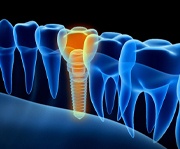
After surgery, you’ll start the osseointegration phase. This step usually takes from 3 to 6 months for your implant to fully integrate into your jawbone, becoming a permanent part of the body. While this may seem like a lengthy timeline, this osseointegration process is precisely what allows implants to look, feel, and function just like natural teeth. This is followed by a minor procedure in which a small connector called an abutment is placed – it acts as a connector that mounts the final restoration on top of the implant.
Delivery of Dental Implant Restoration(s)

The good news is that the toughest part of the process is over! All that’s left to do is to get your final restoration. Typically, we will advise you to visit your general dentist for treatment. They will take impressions of your smile, including your dental implant. Next, they’ll be able to create a custom-made crown, bridge, or denture using the impressions. Once your restoration is placed, your dentist will check that your bite is natural and comfortable. They will ensure you’re satisfied before sending you on your way with a newly complete and healthy set of teeth!
Surgical Dental
Implant Placement
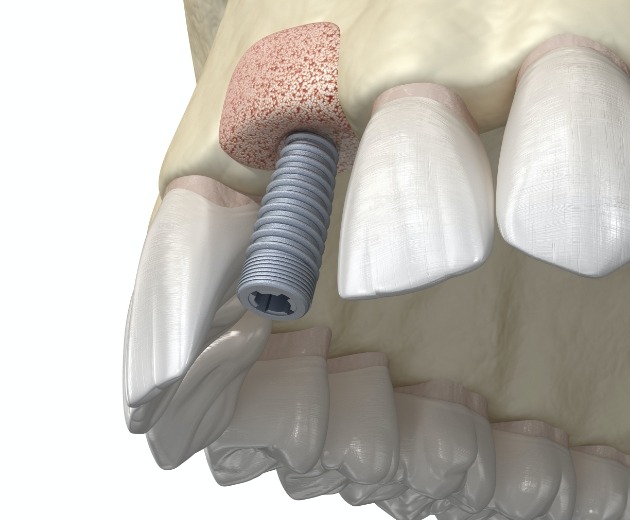
After numbing your mouth, we will make a small incision to open your gum tissue so that we can work with the bone. A hole will be created to insert each dental implant post; the procedure will be carefully planned ahead of time so that we can be sure that the implant is being placed in exactly the right area. After the implants are in place, we’ll close the gums again and place a protective cap over the area to aid the healing process.
Benefits of
Dental Implants

Dental implants remain an unmatched solution to tooth loss because they offer a wide range of benefits that distinguish them from traditional treatments like dentures. As one of the most highly regarded procedures that can help patients who are missing one, several, or all of their teeth, dental implants in Burke have life-changing advantages that make them a popular choice among our patients. Learn more about why this high-tech procedure is preferred to traditional dentures and bridges.
Day-to-Day Benefits

- Improved Eating Abilities. Dental implants have the ability to restore up to 80% of your original bite power due to their increased stability and strength. Since they fuse with the jawbone, they’re unwavering, meaning you can more easily eat foods that are chewy or hard.
- Stability That Makes Speaking Easier. With implant dentures, you won’t have to worry about shifting or slipping prosthetics that cause you to trip over your words. Your prosthetic will remain securely in place, making speaking a breeze.
- Boosted Confidence. One of the greatest benefits of dental implants in Burke is that they’re custom-crafted just for you. They have a resemblance and feel that’s identical to your natural teeth, allowing you to speak and smile with confidence.
- Easier Oral Hygiene Routines. Because implant-retained prosthetics aren’t removable, you’re able to take care of them in the same way you would your natural teeth. Simply continue brushing twice a day, flossing daily, and visiting your dentist for bi-annual checkups and cleanings.
Health Benefits

- Preservation of Jawbone Density. When the roots of missing teeth are no longer stimulating the jawbone, your body will naturally allow it to deteriorate since it believes there’s no longer a use for the bone. This can lead to a variety of unwanted effects, like a change in your facial shape. Dental implants are able to fuse with the bone structure, providing it with necessary blood flow and stimulation to keep this from happening.
- Improved Overall Health. Your oral health is closely linked to the rest of your body, like your cardiovascular system. When the wellbeing of your smile declines due to gaps between your teeth, it can put you at a higher risk of developing other medical conditions. With a complete and healthy smile thanks to dental implants, you’ll be caring for not only your oral health, but also your overall wellbeing.
Long-Term Benefits

Unlike with dentures that you’ll need to replace every seven to 10 years due to jawbone erosion, dental implants are able to last for 35 or more years with the proper maintenance. This means fewer visits to your dentist and less replacement prosthetics. Not only can this save you time, but it will also keep you from spending hundreds of dollars to keep your smile in good health and condition.
Are You a Good Candidate for Dental Implants?

To be a good candidate for dental implants, you need to have an otherwise healthy smile. Two important factors for successful dental implants are healthy gums and substantial bone tissue.
Implants anchor to your jawbone, so you need to have a significant amount of healthy bone tissue in your jaw to support the implant. If you don’t have enough healthy bone tissue in your jaw, the team at Northern Virginia Oral, Maxillofacial & Implant Surgery can perform a bone graft to augment your bone mass.
Healthy gums are also important for successful dental implants. If you’re suffering from gingivitis or periodontal disease, it needs to be treated before getting implants.
Missing Single Tooth
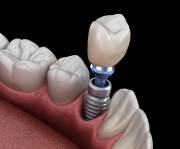
You only need one dental implant to replace a single missing tooth. A crown can be attached to the post once it has been customized to match the shape and color of your other teeth. You’ll protect your natural enamel by getting a single implant post instead of a dental bridge.
Missing Multiple Teeth
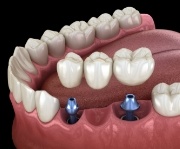
To fill in the empty space left by multiple missing teeth, we can place a pair of dental implants – one at each end of the gap. Then a bridge can be attached to the posts to cover the space. It is also possible to use a small number of implants to support a partial denture.
Missing All of Your Teeth
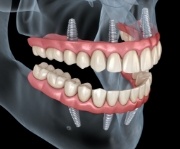
Dental implants can support dentures to replace all your teeth simultaneously. With normal implant techniques, it might take 6 or even 8 implants to support a denture, but with All-on-4, we can minimize the number of implants used while also potentially eliminating the need for bone grafts.
Understanding the Cost of Dental Implants

The cost of dental implants can vary based on how many will be placed and whether preliminary treatments need to be performed. You’ll also have to consider the cost of the final restoration as well. Remember that the initial price of dental implants is often balanced out by their lifespan; they can stay in your mouth for decades without needing to be replaced, so you’re less likely to need to pay for new ones in the future.
Preliminary Treatments & Dental Implant Surgery
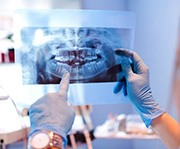
In certain cases, preparatory treatments may be needed in order to complete dental implant placement. For example, you may need to have teeth extracted or bone grafting completed depending on the circumstance. These services, as well as the surgery and anesthesia needed to complete treatment, all carry their own specific costs. If you were referred to our practice by your dentist, keep in mind that what you pay at NOVA will be separate from the fees you’ll pay for other stages of your treatment, such as the permanent restoration.
The Parts of Your Dental Implant
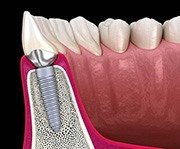
The more dental implants you need will affect your final cost. This is because of the additional time required to complete surgery as well as the extra materials to create your titanium implant posts. Much like cars or electronics, implants can come in different models and be created by specific manufacturers that charge unique fees. Our office is dedicated to being as transparent as possible about the implants we use and why we think they are the best option for replacing teeth.
Final Dental Implant Restoration
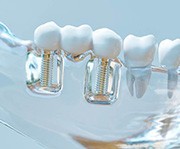
Restorations used to cover your dental implants and complete your smile will vary in cost dramatically based on a few different factors. For one, a single implant crown can be made from a single block of porcelain and customized to attach to an implant quite easily. In contrast, a dental bridge or denture customized for dental implants will take more materials, time, and labor to fabricate, resulting in higher costs. You’ll need to speak with your referring dentist directly about the final price tag of your restoration.
Does My Dental Insurance Cover Dental Implants?

Dental insurance does not typically cover dental implants because they aren’t considered medically necessary by most insurers. However, there are some instances where specific services can have a portion of their costs covered by insurance. This includes preparatory treatments like extractions, bone grafting, and even the restorations. You’ll need to speak with your dentist or insurance provider directly to confirm if any coverage is available.
Making Dental Implants Affordable

Don’t have dental insurance? Your dental implant treatment can still be made affordable through other financing options. This includes payment plans from third-party companies like CareCredit. With it, you can cover the cost of services typically out of reach by signing up for one of their payment plans. Over the course of several months, you can break up the cost of your treatment into monthly chunks, rather than paying in one lump sum. Plus, you can even expect little to no interest attached depending on the plan you choose.
Advanced Dental Implant Procedures

As complex as the implant placement procedure is itself, in many cases, preliminary work is needed to ensure that treatment is successful. The good news is that our team of experts can perform basically any necessary work, meaning you don’t have to work with another office for comprehensive dental implant care. The implant procedures we provide are designed to help prepare your smile for implants so that you can hold onto your replacement teeth for as long as possible. Here are some of the advanced procedures we offer.
Bone Grafting
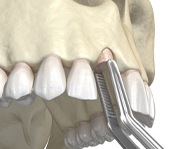
To have successful implants, one major requirement is to have enough jawbone tissue to support the posts. Without it, the replacement would not have the strength and stability that implants are known for. Whether due to prolonged tooth loss or conditions like osteoporosis, you may not have sufficient bone density on your own. A bone graft supplements your natural bone and stimulates new growth. After several months following a graft, your jawbone tissue can be ready to receive implants and serve as a strong foundation for your replacement teeth.
Sinus Lift
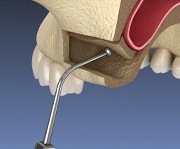
Replacing teeth in the upper arch can be more complicated than in the lower. Because of its proximity to the sinuses, there is often limited room for adding bone density. A sinus lift entails physically raising the sinus boundary higher so that a bone graft can be inserted into the area, significantly increasing the capacity to support implants. As a result, this procedure also increases the chances of successful implants on the top row of teeth.
PRP/PRF Treatment

In other fields, platelet rich plasma (PRP) and platelet rich fibrin (PRF) have been found to be beneficial in many situations throughout the body. In fact, PRP and PRF treatment is widely used to not only combat signs of aging in the skin but also encourage new cell growth and regeneration, leading to faster healing times following surgery or injuries. When it comes to implants, we take a small amount of your own blood, put it in a centrifuge, where the plasma is separated. Then, the PRP is reinjected into the area where you need this extra regenerative boost.
Ridge Expansion
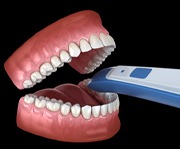
The jawbone needs to have the right breadth, as well as reach a certain height, in order to qualify for dental implants. In other words, without a wide enough bone ridge, the implants will not become completely stable. A ridge expansion consists of surgically widening the bone horizontally so that it can envelop the implant completely, providing more security. This procedure often combined with a bone graft and can require several months afterward for the jawbone to fully recover.
Dental Implant Failure & Salvage
Dental implants have an incredible success rate of over 95%, even a decade after placement! However, there is still the rare chance that you could endure a dental implant failure. If your newly restored smile starts to feel uncomfortable or you have concerns regarding your implants, give us a call. We may be able to save your smile with dental implant salvage treatment!
Learn More About Dental Implant Failure & Salvage

Dental Implant Technology
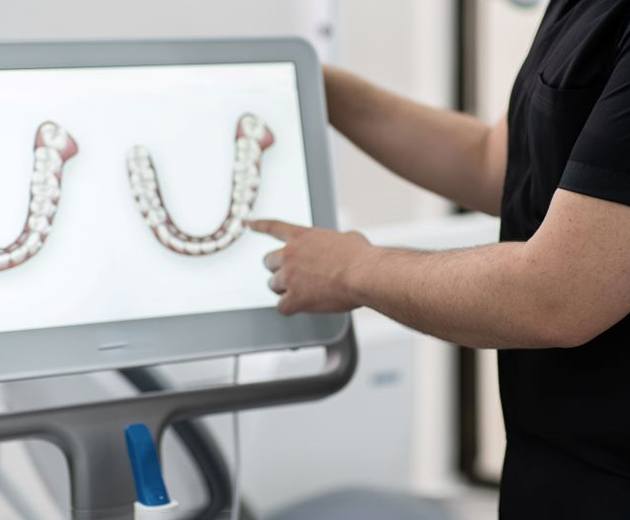
The education, skills, and commitment to excellence possessed by our oral surgeons play a huge role in creating positive treatment outcomes for our patients. However, the instruments we use are also important. Read on below to learn about some of the state-of-the-art technology that may contribute to your new smile.
CBCT Imaging
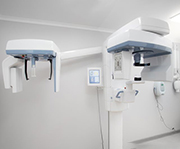
Some dental practices rely on regular digital X-rays for all or most of their imaging needs. While X-rays are certainly valuable, they can only produce two-dimensional images. They also do not provide the high level of detail that is often needed during dental implant procedures.
That is why we have invested in a CBCT scanner, which may also be referred to as a cone-beam scanner. It uses the same type of radiation as an X-ray, but it is emitted in a cone-shaped beam. The machine is able to produce highly detailed, three-dimensional images of a patient’s teeth, jawbone, nerves, and connective tissues.
We may use our CBCT machine to determine if you are a candidate for dental implants. We can also use it to plan where to place them in your bone. After you receive implants, it can help us to monitor how well they are bonding with the surrounding tissue.
Guided Dental Implant Surgery
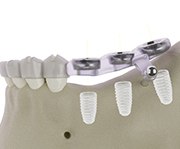
There are a few different approaches to dental implant surgery. In some cases, freehand placement is fine; it involves taking a well-educated guess as to where, how deep, and at what angle the dental implants should be placed in a patient’s jawbone. It often works well in instances where a patient has few or no complicating factors in their case.
Guided dental implant surgery involves the use of a custom surgical guide that helps us place the implants at exactly the right place. It minimizes human error and can reduce the risk of dental implant failure, especially in instances where we have to place multiple implants or a patient has unusual features in their oral anatomy.
Although the guided surgery process can take longer and be a bit costlier than freehand surgery, the benefits it offers make it a worthwhile investment. We do not want to take any unnecessary chances with your oral health!
Digital Impression System
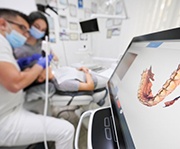
After your dental implants have integrated with your jawbone, we will need to restore them — that is, we will design a crown, bridge, or denture to attach to them. The old-fashioned way of designing restorations involved manual impressions, which required a patient to bite down on a putty. Sometimes, impressions had to be taken multiple times to ensure accuracy.
Today, we prefer digital impressions. We simply use a wand-like device to capture thousands of images of your mouth. Our computer then assembles them into an accurate model of your remaining teeth and gumline so we can make sure that your new teeth are a perfect fit for your smile. The scanning process is very fast, very comfortable, and involves absolutely no unpleasant putty.
Dental Implant Post-Op Instructions
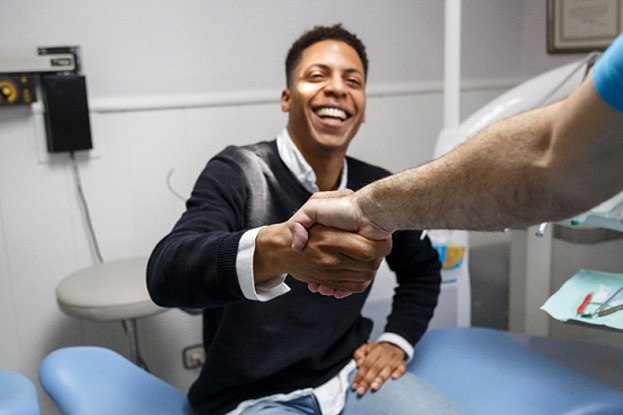
The recovery phase after dental implant surgery is long but simple. With the right guidance and plenty of rest, you’ll have no problems keeping your newly implanted fixtures happy so they can successfully integrate with your jawbone. Below, you’ll find all you need to know to help your smile heal and how to spot signs that you may be experiencing complications. Our team at Northern Virginia Oral, Maxillofacial & Implant Surgery is dedicated to your oral health, so don’t hesitate to reach out for more information.
What to Do Directly After Dental Implant Surgery

After your dental implant surgery, a blood clot will form around the implant site, kickstarting your natural healing processes. It’s important to avoid any of the following activities to ensure that the site remains undisturbed:
- Don’t spit, including after dental hygiene. Instead, let the saliva fall out of your mouth or use tissues.
- Don’t use straws or create suction in your mouth. This could dislodge the blood clot and lead to complications.
- Don’t smoke or drink alcohol. Both products can interfere with your body’s ability to heal.
- Don’t touch the surgical site with your tongue or fingers.
Common Side-Effects When Recovering from Dental Implant Placement

There may be some side-effects after your dental implant surgery, but they are usually mild and will fade over time. Here are some of the issues you may encounter:
- Light bleeding is normal, even if it continues for a few days. Use some sterile gauze and light pressure to keep it under control.
- Swelling around the implant site generally lasts for 72 hours to a week after your surgery. Use a warm or cold compress with 20-minute intervals to help reduce it.
- Discomfort or tenderness may also occur around your implant fixture. Generic pain medication like ibuprofen can help.
- If you develop severe pain, fever, profuse bleeding, or other concerning symptoms, call us to schedule a follow-up appointment.
Your Diet After Dental Implant Surgery

You’ll also need to alter your diet for a few days after your surgery. Our team recommends planning out a menu of soft, non-abrasive foods, such as:
- Mashed potatoes
- Ice cream
- Smoothies
- Yogurt
- Pasta
- Scrambled eggs
- Warm (not hot) soup
- Pudding
While every patient is different, it’s recommended to avoid foods that involve more chewing for at least the first 24 – 72 hours to ensure that your implant has had time to begin healing.
Post-Op Health & Oral Hygiene

Oral hygiene is one of the most critical aspects of your recovery. You’ll need to continue your regular care routine but be careful for the first day or two.
- Brush as normal but be very gentle around the implant site.
- Rinse your mouth after every meal (or at least three times per day) by softly swishing with warm salt water.
- Avoid mouthwashes with alcohol content like Scope or Listerine as these will dry out your mouth and inhibit healing.
What to Do After Your New Teeth Are Attached
Once your new crown, bridge, or denture is attached, the hardest part is over! While there may still be a bit of minor sensitivity in the area around your gums, this will fade relatively quickly. There shouldn’t be any more bleeding or swelling after the crown is placed. Any traces of discomfort can be addressed with over-the-counter pain medications.
Maintaining & Caring for Your Dental Implants

Although dental implants come with an incredibly high success rate of 95% or more, and they can generally last several decades to a lifetime, you’ll have to practice certain measures to make this possible. While your metal posts won’t decay or develop cavities, the surrounding gum and jawbone tissue can still be vulnerable to bacteria. Additionally, you’ll want to minimize the possibility of accidentally damaging your restoration later on. Here are several tips for maintaining your dental implants.
Make Oral Hygiene a Priority

Just like with your normal pearly whites, you should always brush, floss, and rinse with mouthwash every day. The last thing you want is to allow bacteria to accumulate along the gum line and increase the risk of peri-implantitis—an infection that can attack and destroy the connective tissues holding your dental implants in place. By simply cleaning your teeth every morning and before bed, you can significantly reduce your chances of developing this issue.
Eat a Healthy Diet

With dental implants, you’ll be able to make the most of a renewed bite, as most patients typically regain around 80% or more of their natural chewing ability. Not only does this mean you can enjoy your favorite foods and treats, but you can also expand your diet to include more nutritional choices. By eating more vitamin-rich meals, such as fruits, veggies, lean meats, and dairy products, you’ll be able to promote healthier and stronger bone tissue in the long run.
Break Bad Habits

To make the most of your dental implants, you’ll need to minimize any possibility of accidentally damaging them or contaminating the gum and bone tissue surrounding them. This means you’ll want to work on breaking any poor oral habits that could put them at risk of failure, such as chewing on ice, using your teeth as tools, and using tobacco products. If you need help quitting smoking, don’t hesitate to get in touch with our team, as we can provide you with resources, support, and guidance during this change.
Protect Your Dental Implants
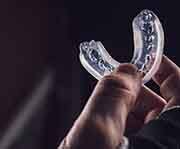
While you can practice daily oral hygiene diligently, accidents can happen at any time. If you tend to play physical sports, the last thing you want is to accidentally harm your new pearly whites. That’s why it’s best to invest in custom mouthguards, that way your teeth have the protection necessary to keep them safe while you enjoy your game. If you clench or grind your teeth at night, you might also consider getting nightguards for Bruxism so that you can avoid wear and tear during sleep.
Schedule Regular Dental Checkups

Other than brushing and flossing every day, you’ll want to keep visiting your dentist regularly every six months. Not only can they check your dental implants and polish your smile, but they can also address any underlying problems that can raise complications in the future. Early prevention can even help you avoid costly treatments later on.
Dental Implant FAQs

If you’re curious about dental implants in Alexandria, you’re in the right place! For any specific concerns, please don’t hesitate to contact our friendly front desk team. Until then, we want to make it as easy as possible to get the information you need. That’s why we’ve included the answers to some of the most frequently asked questions we get about dental implants below.
How Long Do Dental Implants Last?
Dental implants are incredibly durable. They are designed to last for over 30 years and even the rest of your life with proper care. However, their lifespan depends directly on your health and lifestyle. To get the most out of your implants, be sure to brush twice a day and floss once a day. Use a nonalcoholic mouthwash and avoid tobacco use. Smoking and tobacco products slow down healing while also promoting infection. Additionally, do not use your teeth for anything other than eating and speaking – using them as tools to open packages can damage your implants and decrease their lifespan.
Can I Take Dental Implants Out?
One of the reasons why dental implants are so popular is that they feel like natural teeth. This is made possible because they fuse to the jawbone to become a permanent part of the body. For this reason, dental implants cannot be removed except by a trained dental professional. Implants are made of biocompatible materials that allow them to integrate with the jawbone during a process called osseointegration. However, some implant dentures are designed so they patient can take out their dentures for cleaning and put them back in with the support of dental implants.
Does Getting Dental Implants Hurt?
The good news is that the dental implant surgery is much more painless than you may expect. Our implant dentist in Alexandria will always ensure that you’re numb and comfortable before beginning. Additionally, your jawbone doesn’t contain very many pain-sensing nerves, which means a more comfortable procedure. That said, it’s normal to experience some slight soreness after the surgery. This can be managed with pain medication and following our post-op instructions. You can also use a cold compress to reduce swelling. If your soreness or pain seems to get worse after 2 or 3 days, call us right away!
Are Dental Implants Safe?
Dental implants are great for most patients who have good health. You can enjoy peace of mind and boosted confidence knowing that dental implants have a success rate of 95% even after 10 years. Problems like low jawbone density and gum disease can cause implants to fail, however we offer treatment options to correct these issues and increase your chance of a successful procedure. During an initial consultation, we will review your medical history and examine your mouth. If you have medical conditions like diabetes or cancer, we will discuss your options during your appointment.
What Can Cause Implants to Fail?
Dental implant failure typically results from either peri-implantitis or failed osseointegration. Peri-implantitis is a gum disease caused by poor oral hygiene that damages the gums and bone supporting the implant. Failed osseointegration occurs when the implant does not properly fuse with the jawbone, often due to low bone density.
Other contributing factors include chronic teeth grinding, smoking, certain medications, and radiation to the head and neck. Health conditions such as diabetes, cancer, osteoporosis, and autoimmune disorders can also increase the risk of failure. Maintaining excellent oral hygiene and following proper care instructions are essential to ensure the long-term success of your newly rebuilt smile!
Am I Too Young to Get Dental Implants?
Dental implants are typically not recommended for patients under 18, as the jaw must be fully developed for successful placement. If implants are placed too early, they can interfere with natural bone growth and lead to complications. While many people reach full jaw maturity in their late teens, others (especially men) may not fully develop until their mid-20s.
Because jaw development varies from person to person, dental professionals assess each case individually. If you're considering implants and are still relatively young, our team will evaluate your jaw growth and determine the right timing. Waiting until full development will ensure the implant’s long-term stability and success.
Will I Have to Take Off Work for Dental Implant Surgery?
Luckily, most patients only need to take one or two days off work for dental implant surgery. Of course, the recovery time can vary depending on the complexity of your case. Your dentist will provide specific guidance based on your individual needs. If your job involves physical labor or strenuous activity, it's best to take at least three to four days off, as heavy exertion can interfere with healing by diverting blood flow from the implant site.
To minimize time away from work, many patients choose to schedule their procedure on a Thursday or Friday, allowing them to recover over the weekend. Always follow our aftercare instructions to ensure a smooth and successful recovery.
Can I Get Dental Implants If I Smoke?
Yes, but it's important to know that smoking significantly increases the risk of implant failure. Tobacco use can delay healing, dry out the mouth, and interfere with the implant’s ability to bond with the jawbone. It also increases the risk of dry socket – a painful condition where the blood clot at the surgical site becomes dislodged.
If you’re a smoker, you should quit at least two weeks before your procedure and avoid tobacco for at least two to three months afterward to support healing. This process can be a great opportunity to quit smoking altogether, which would benefit both your dental health and overall well-being.
